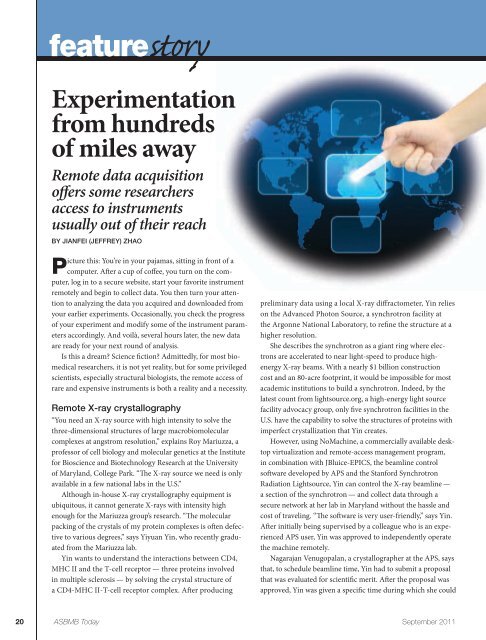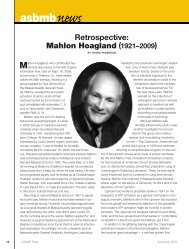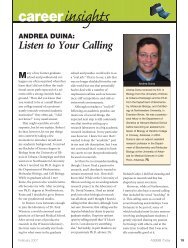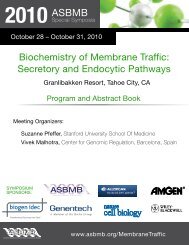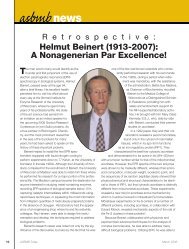asbmbnews
asbmbnews
asbmbnews
You also want an ePaper? Increase the reach of your titles
YUMPU automatically turns print PDFs into web optimized ePapers that Google loves.
featurestory<br />
Experimentation<br />
from hundreds<br />
of miles away<br />
Remote data acquisition<br />
offers some researchers<br />
access to instruments<br />
usually out of their reach<br />
BY JIANFEI (JEFFREY) ZHAO<br />
Picture this: You’re in your pajamas, sitting in front of a<br />
computer. After a cup of coffee, you turn on the computer,<br />
log in to a secure website, start your favorite instrument<br />
remotely and begin to collect data. You then turn your attention<br />
to analyzing the data you acquired and downloaded from<br />
your earlier experiments. Occasionally, you check the progress<br />
of your experiment and modify some of the instrument parameters<br />
accordingly. And voilà, several hours later, the new data<br />
are ready for your next round of analysis.<br />
Is this a dream? Science fiction? Admittedly, for most biomedical<br />
researchers, it is not yet reality, but for some privileged<br />
scientists, especially structural biologists, the remote access of<br />
rare and expensive instruments is both a reality and a necessity.<br />
Remote X-ray crystallography<br />
“You need an X-ray source with high intensity to solve the<br />
three-dimensional structures of large macrobiomolecular<br />
complexes at angstrom resolution,” explains Roy Mariuzza, a<br />
professor of cell biology and molecular genetics at the Institute<br />
for Bioscience and Biotechnology Research at the University<br />
of Maryland, College Park. “The X-ray source we need is only<br />
available in a few national labs in the U.S.”<br />
Although in-house X-ray crystallography equipment is<br />
ubiquitous, it cannot generate X-rays with intensity high<br />
enough for the Mariuzza group’s research. “The molecular<br />
packing of the crystals of my protein complexes is often defective<br />
to various degrees,” says Yiyuan Yin, who recently graduated<br />
from the Mariuzza lab.<br />
Yin wants to understand the interactions between CD4,<br />
MHC II and the T-cell receptor — three proteins involved<br />
in multiple sclerosis — by solving the crystal structure of<br />
a CD4-MHC II-T-cell receptor complex. After producing<br />
preliminary data using a local X-ray diffractometer, Yin relies<br />
on the Advanced Photon Source, a synchrotron facility at<br />
the Argonne National Laboratory, to refine the structure at a<br />
higher resolution.<br />
She describes the synchrotron as a giant ring where electrons<br />
are accelerated to near light-speed to produce highenergy<br />
X-ray beams. With a nearly $1 billion construction<br />
cost and an 80-acre footprint, it would be impossible for most<br />
academic institutions to build a synchrotron. Indeed, by the<br />
latest count from lightsource.org, a high-energy light source<br />
facility advocacy group, only five synchrotron facilities in the<br />
U.S. have the capability to solve the structures of proteins with<br />
imperfect crystallization that Yin creates.<br />
However, using NoMachine, a commercially available desktop<br />
virtualization and remote-access management program,<br />
in combination with JBluice-EPICS, the beamline control<br />
software developed by APS and the Stanford Synchrotron<br />
Radiation Lightsource, Yin can control the X-ray beamline —<br />
a section of the synchrotron — and collect data through a<br />
secure network at her lab in Maryland without the hassle and<br />
cost of traveling. “The software is very user-friendly,” says Yin.<br />
After initially being supervised by a colleague who is an experienced<br />
APS user, Yin was approved to independently operate<br />
the machine remotely.<br />
Nagarajan Venugopalan, a crystallographer at the APS, says<br />
that, to schedule beamline time, Yin had to submit a proposal<br />
that was evaluated for scientific merit. After the proposal was<br />
approved, Yin was given a specific time during which she could<br />
20 ASBMB Today September 2011


